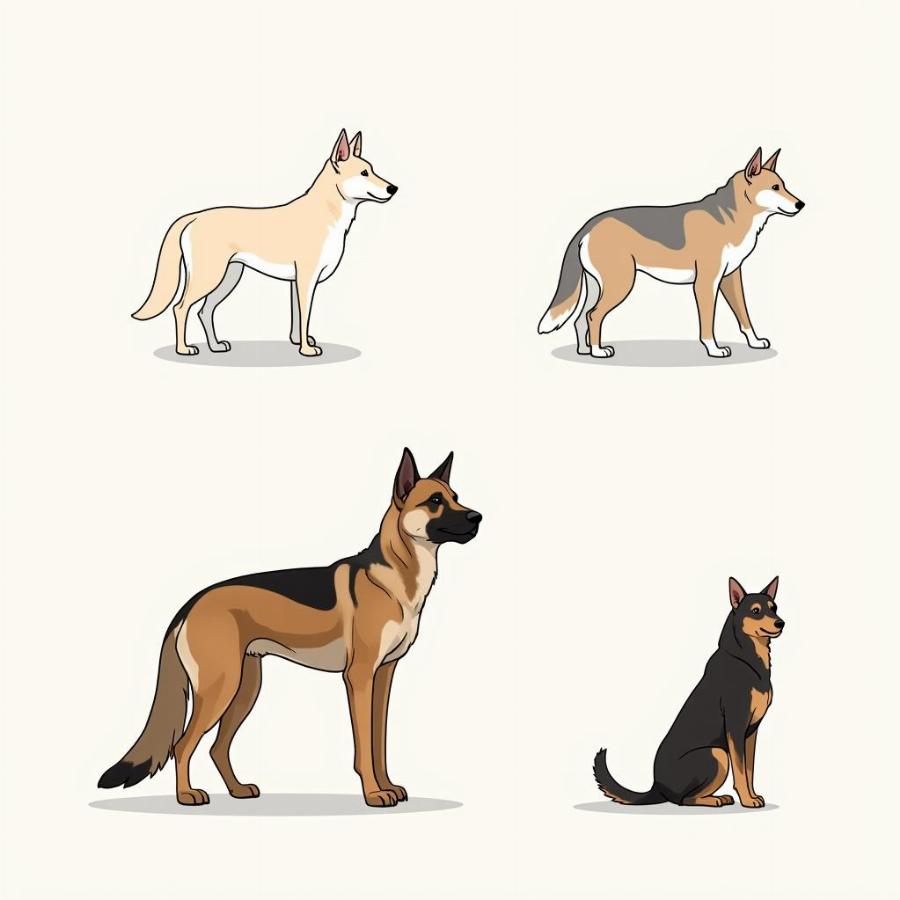Coyotes and dogs, while sharing a common ancestor, possess distinct characteristics that set them apart. Understanding these differences is crucial, especially for dog owners living in areas where coyotes roam. This article will delve into the physical attributes, behavioral patterns, and potential interactions between coyotes and domestic dogs, providing valuable insights for responsible pet ownership and promoting peaceful coexistence.
Physical Distinctions: Spotting a Coyote
Can you tell a coyote from a dog? While some breeds might resemble coyotes, there are key physical differences. Coyotes are typically smaller than large dog breeds, with a leaner build, longer legs, and a bushier tail often held low to the ground. Their pointed snout and erect, pointed ears are also characteristic features. Coyotes generally have a grayish-brown coat, unlike the varied colors found in domestic dogs. The combination of these physical attributes provides a distinctive profile that sets coyotes apart.
 Coyote vs Dog: Physical Differences
Coyote vs Dog: Physical Differences
Behavioral Differences: Wild vs Domesticated
Beyond physical appearance, behavioral differences significantly distinguish coyotes from dogs. Coyotes are wild animals, exhibiting a natural wariness and avoidance of humans. They are crepuscular, meaning they are most active at dawn and dusk. Their vocalizations are distinct, ranging from high-pitched yips and howls to barks and growls, often used for communication within their pack. Domestic dogs, on the other hand, are generally more comfortable around humans, displaying a range of behaviors depending on breed and training. They are typically diurnal, active during the day, and their vocalizations vary widely based on breed and individual personality.
Coyote and Dog Interactions: Coexistence and Conflict
The increasing overlap of coyote and dog habitats has led to more frequent interactions, raising concerns about potential conflict and hybridization. Coyotes are naturally territorial and may view dogs as rivals, particularly during mating season. Encounters can result in aggressive behavior, posing risks to both animals. While coyotes generally avoid humans, they may be attracted to dog food left outdoors, increasing the likelihood of interaction. Understanding these dynamics is essential for mitigating potential conflicts. Coyotes vs dogs, in this context, highlights the need for responsible pet ownership in areas where these two species cohabitate. For example, a pet fence small dogs can utilize can also keep coyotes out of your yard.
Will Coyotes Mate with Dogs?: Understanding Coydogs
One common question is, will a coyote mate with a dog? Yes, coyotes and domestic dogs can interbreed, resulting in offspring known as coydogs. Coydogs inherit a mix of traits from both parents, and their appearance and behavior can vary considerably. The occurrence of coydogs raises complex ecological and management issues. While some view them as a natural adaptation, others worry about the potential impact on both coyote and dog populations.
For those interested in the broader canid family, you may also find our comparison of jackal and dog informative.
Protecting Your Pets: Practical Tips for Coexistence
Living in coyote country requires proactive measures to protect your furry friends. Keeping dogs on a leash, especially during dawn and dusk, is crucial. Securely fencing your yard can deter coyotes from entering and prevent your dog from wandering into their territory. Avoid leaving pet food outdoors, as it can attract coyotes. Properly disposing of garbage and removing potential food sources can also minimize the risk of encounters. Understanding the difference between coyotes vs dogs is the first step towards responsible pet ownership in shared habitats. Similar to how you’d protect your smaller pets from gophers, you can employ strategies to keep them safe from coyotes. For smaller breeds, a pet fence small dogs can be particularly effective.
Conclusion: Living Harmoniously with Coyotes
Understanding the distinctions between coyotes and dogs is fundamental for peaceful coexistence. By recognizing their unique characteristics, respecting their wild nature, and taking appropriate precautions, we can minimize potential conflicts and ensure the safety of our beloved pets. Remember, responsible pet ownership plays a vital role in promoting harmony between humans, dogs, and the wildlife around us. Those interested in other wildlife comparisons might also find our article on prairie dog vs gopher interesting.
FAQ: Common Questions About Coyotes and Dogs
- Are coyotes dangerous to humans? Coyote attacks on humans are rare. Coyotes are generally wary of humans and prefer to avoid contact.
- What should I do if I encounter a coyote? Make yourself appear large, make noise, and slowly back away. Do not run.
- Do coyotes prey on pets? Small pets can be vulnerable to coyote predation. Take precautions to protect your pets, especially smaller dogs and cats.
- Can coydogs be domesticated? Coydogs inherit wild instincts from their coyote parent, making domestication challenging and unpredictable.
- How can I prevent coyotes from entering my yard? Secure fencing, removing attractants like pet food, and proper garbage disposal can help deter coyotes.
- What sounds do coyotes make? Coyotes communicate through a variety of vocalizations, including howls, yips, barks, and growls.
- Are coyotes active during the day? While primarily crepuscular, coyotes can be active during the day, especially when food is scarce.
Further Exploration: More on Canids and Pet Safety
Looking to learn more? Explore our articles on will a coyote mate with a dog for a deeper understanding of coydog hybridization.
Beaut Dogs: Your Premier Resource for Canine Information
Beaut Dogs is your go-to resource for all things canine, offering expert advice and insightful information on dog breeds, care, and responsible ownership. When you need expert advice, contact us at Email: [email protected] for detailed and accurate answers from Beaut Dogs. Visit https://beautdogs.com today to explore the wonderful world of dogs and learn how to provide the best possible care for your furry companion.